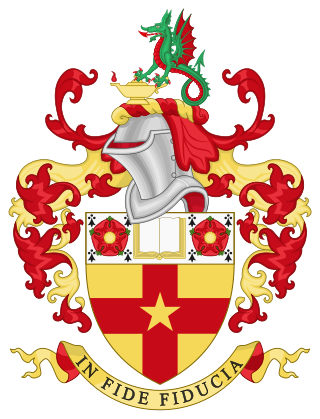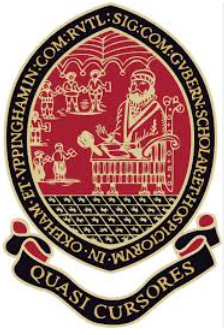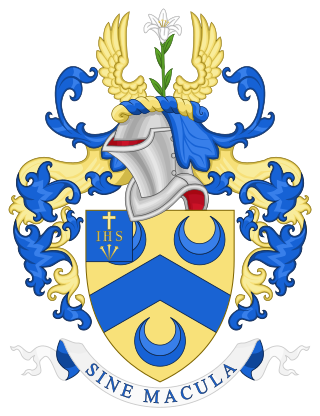
Rugby School is a public school in Rugby, Warwickshire, England.

Clifton College is a public school in the city of Bristol in South West England, founded in 1862 and offering both boarding and day school for pupils aged 13–18. In its early years, unlike most contemporary public schools, it emphasised science rather than classics in the curriculum, and was less concerned with social elitism, for example by admitting day-boys on equal terms and providing a dedicated boarding house for Jewish boys, called Polack's House. Having linked its General Studies classes with Badminton School, it admitted girls to every year group in 1987, and was the first of the traditional boys' public schools to become fully coeducational. Polack's House closed in 2005 but a scholarship fund open to Jewish candidates still exists. Clifton College is one of the original 26 English public schools as defined by the Public Schools Yearbook of 1889.

The Judd School is an 11–18 voluntary aided, grammar school and sixth form in Tonbridge, Kent, England. It was established in 1888 at Stafford House on East Street in Tonbridge, where it remained for eight years before moving to its present location on Brook Street, in the south of the town. Founded by the Worshipful Company of Skinners, it was named after 16th century merchant Sir Andrew Judde, whose endowment helped fund the school. The Skinners' Company maintains close links with the school and makes up the majority of the governing body.

Bedford School is a 7–18 boys public school in the county town of Bedford in England. Founded in 1552, it is the oldest of four independent schools in Bedford run by the Harpur Trust. Bedford School is one of the oldest boys' schools in the United Kingdom, and was the winner of the Independent Boys School of the Year Award at the Independent Schools of the Year Awards in 2021.

The Leys School is a co-educational private school in Cambridge, England. It is a boarding and day school for about 574 pupils between the ages of eleven and eighteen, and the head is a member of the Headmasters' and Headmistresses' Conference.

Oakham School is a public school in Oakham, Rutland, England.

Sedbergh School is a public school in the town of Sedbergh in Cumbria, North West England. It comprises a junior school for pupils aged 4 to 13 and the main school for 13 to 18 year olds. It was established in 1525.
Michael William McCrum CBE was an English academic and ancient historian who served as Vice-Chancellor of the University of Cambridge, Master of Corpus Christi College, Cambridge, and Head Master of Tonbridge School and Eton College.

Mount St Mary's College is a private, co-educational, day and boarding school situated at Spinkhill, Derbyshire, England. It was founded in 1842 by the Society of Jesus, and has buildings designed by notable architects such as Joseph Hansom, Henry Clutter and Adrian Gilbert Scott. The school is a member of the Headmasters' and Headmistresses' Conference and the Catholic Independent Schools Conference.

St. Andrew's College is an Anglican high school for boys located in Makhanda (Grahamstown), Eastern Cape province of South Africa. It was founded in 1855 by the Right Reverend John Armstrong, the first Bishop of Grahamstown. It is a semi-boarding school, with a number of day boys. St. Andrew's College caters to 480 pupils from around the globe. The school is also a member of the G30 Schools group and closely associated with its brother school, St. Andrew's Preparatory School, and its sister school the Diocesan School for Girls.

Hilton College, more commonly referred to as Hilton, is a South African private boarding school for boys located near the town of Hilton in the KwaZulu-Natal Midlands and is situated on a 1,762 ha estate that includes a 550 ha wildlife reserve and the 150 ha school campus

Christ College, Brecon, is a co-educational, boarding and day independent school, located in the cathedral and market town of Brecon in mid-Wales. It currently caters for pupils aged 7–18 years.

Cranleigh School is a public school in the village of Cranleigh, Surrey.

The Skinners' School, is a British Grammar School with academy status for boys located in the town of Royal Tunbridge Wells, Kent, England. Established in 1887, the school was founded by the Worshipful Company of Skinners in response to a demand for education in the region. Today Skinners' remains an all-boys grammar school, recently awarded specialist status in science and mathematics in recognition of these disciplines' excellent teaching. The current enrolment is 1119 pupils, of whom around 326 are in the sixth form. The first headmaster was Reverend Frederick Knott, after whom Knott House is named. The current Headmaster is Edward Wesson.

Launceston Church Grammar School is an Anglican co-educational private school in Launceston, Tasmania, Australia for Early Learning through to Grade 12.

Eastbourne College is a co-educational fee-charging school in the English public school tradition, for boarding and day pupils aged 13–18, in the town of Eastbourne on the south coast of England. The College's headmaster is Tom Lawson.
Kent College, Canterbury is a co-educational private school for boarding and day pupils between the ages of 3 months and 18 years. It was founded in 1885, and is a member of the Headmasters' and Headmistresses' Conference. Originally established as a boys' public school, it admitted girls into the sixth form in 1973 and since 1975 it has been fully co-educational.

Douai School was a public school run by the Douai Abbey Benedictine community at Woolhampton, England, until it closed in 1999.

Estcourt High School is a school in Estcourt, South Africa that traces its origins to the Estcourt Government School which was founded in 1886. The high school itself was founded in 1924 when the government school was split into a high school and a junior school.

Bede's School, consists of a preparatory school and pre-preparatory nursery in Holywell, Meads, Eastbourne, East Sussex, England, as well as a senior school based in Upper Dicker, Hailsham, East Sussex, England. These, along with the Legat School of Dance, form the Bede's School Trust, an educational charity. All three institutions are private fee-charging schools.























